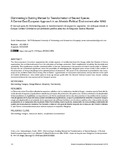Dümmerling’s Guiding Manual for Transformation of Sacred Spaces: A Central-East-European Approach in an Atheistic Political Environment after WW2

Ver/
Use este enlace para citar
http://hdl.handle.net/2183/25387
A non ser que se indique outra cousa, a licenza do ítem descríbese como Atribución-NoComercial 4.0 España
Coleccións
Metadatos
Mostrar o rexistro completo do ítemTítulo
Dümmerling’s Guiding Manual for Transformation of Sacred Spaces: A Central-East-European Approach in an Atheistic Political Environment after WW2Título(s) alternativo(s)
El manual-guía de Dümmerling para la transformación de espacios sagrados: un enfoque desde la Europa Central-Oriental en un ambiente político ateo tras la Segunda Guerra MundialAutor(es)
Data
2020Cita bibliográfica
Vukoszávlyev, Zorán. 2019. «El Manual-guía De Dümmerling Para La transformación De Espacios Sagrados». Actas De Arquitectura Religiosa Contemporánea 6 (diciembre), 144-55. https://doi.org/10.17979/aarc.2019.6.0.6235
Resumo
[Abstract] The Sancrosanctum Concilium approaches the artistic aspects of architecture from the liturgy, while the Charter of Venice
approaches the architectural space from the principles of heritage protection. Both emphasized simplicity, functionality and
readability. The significance and the combined effect of the two documents in the practice of church construction in Eastern
Europe can be considered significant, since the possibility of redesigning the liturgical space arose mainly in the context of
the renovation of historic buildings in the atheist political environment. The proof of this statement is presented in the manuscript
of the architect Ödön Dümmerling. The architect - a practitioner of monument restorations and an admirer of the spirit
of modern architecture - was called upon to draw up design guide after the Second Vatican Council was closed, making
recommendations for new equipment for liturgical spaces. [Resumen] La Sancrosanctum Concilium aborda los aspectos artísticos de la arquitectura desde la liturgia, mientras que la Carta de Venecia
aborda el espacio arquitectónico desde los principios de protección del patrimonio. Ambos enfatizaron la simplicidad,
la funcionalidad y la legibilidad. La importancia y el efecto combinado de los dos documentos en la práctica de la construcción
de iglesias en Europa del Este pueden considerarse significativos, ya que la posibilidad de rediseñar el espacio litúrgico
surgió principalmente en el contexto de la renovación de edificios históricos en el entorno político ateo. Una prueba de esto
se presenta en el manuscrito del arquitecto Ödön Dümmerling. Este arquitecto, restaurador de monumentos y admirador del
espíritu de la arquitectura moderna, fue llamado a elaborar una guía de diseño después de la clausura del Concilio Vaticano
II, que hiciera recomendaciones para nuevos equipos en espacios litúrgicos.
Palabras chave
Dümmerling
Hungary
Design manual
Simplicity
Functionality
Hungría
Manual de diseño
Simplicidad
Funcionalidad
Hungary
Design manual
Simplicity
Functionality
Hungría
Manual de diseño
Simplicidad
Funcionalidad
Versión do editor
Dereitos
Atribución-NoComercial 4.0 España
ISSN
2340-5503






